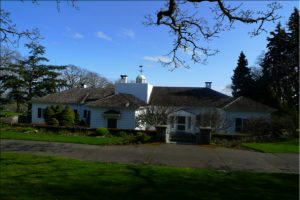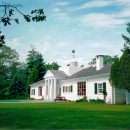Swanwick Star Issue No. 4 (2011)
A Short History of The Swanwick Study Centre
A Short History of The Swanwick Study Centre by Chris Pratt
 The open meadows that fringe the shores of the sea in Metchosin are the result of the Garry Oak groves that stand there, and the careful cultivation of the camas plant by the First Nations people. They cultivated the camas fields, which form part of the natural order of vegetation, a plant whose bulbs were an important part of their winter diet. The dark Douglas fir forest favoured the deeper soils a bit farther inland.
The open meadows that fringe the shores of the sea in Metchosin are the result of the Garry Oak groves that stand there, and the careful cultivation of the camas plant by the First Nations people. They cultivated the camas fields, which form part of the natural order of vegetation, a plant whose bulbs were an important part of their winter diet. The dark Douglas fir forest favoured the deeper soils a bit farther inland.
This open land attracted the first settlers to Metchosin, the Weir family from Scotland in this case. In 1859. Robert Weir, known affectionately by his family and friends as “The Laird”, was a widower with three grown sons and four young children. Only a bridle path linked their farm with Victoria when they first built their home here, and all heavy freight was landed over the beach. The beach is still known as the Laird’s Beach.
Actually, the Weir family had been living in Sooke for a few years, and the only overland connection between there and Victoria was by a path that led past Matheson Lake and Pedder Inlet to Sandy Bay (Weir’s Beach), and from there along the shoreline to Albert Head and beyond. That shore path is still in local use by Metchosin folk. And that was how the Weirs were originally attracted to this piece of potential farmland. They named it “Gordon Bush” after their Scottish home.
Gradually the Weir family added to their holdings until their lands extended to a thousand acres (400ha) and their sheep numbered almost a thousand head when they took custody of the Hudson’s Bay Co. flock. Robert and his four sons formed a partnership, and some years later the youngest son, Adam, established his own farm on the land adjoining Gordon Bush to the south. The Helgesen family took up the land to the north of the Weirs, and the lane separating the two farms has become Swanwick Road, named for a Weir son-in-law, Thomas F Swanwick.
The Laird died in 1895, and Gordon Bush was sold out of the family in the early 1900’s. The old farm house burned down in 1912. It was located near the present tennis court.
The Weir holdings have now passed to other owners: the Army took up a large portion of it when a heavy gun battery was installed atop Mary Hill at the beginning of the Second World War, and the land around Weir’s Beach has become privately owned. The home farm itself has had several owners:
First, a family by the name of Charlesworth, about which little is known.
Next, early in the 1920’s, an American international lawyer, David Hunter Miller, bought the property. He had been an adviser to the US Government at the time of settling the Alaska Boundary with Canada, and later was adviser to President Wilson at the signing of the Treaty of Versailles. He and his wife built a comfortable home, which they named “Craiglands”, and continued to enjoy a secluded retirement there.
The property came on the market again in 1950 and was bought by Mr. and Mrs. G.S.M. Warlow, Victoria residents, for their daughter Mary. They renamed the property “Gatherly” after a home in England. There was a second house on the property that stood on the site of the two cottages used by the present owners. Tony Mitchell lived there with his family, and raised turkeys on the land. The present office building and living accommodation began their life as a turkey barn.
It was sold again in about 1956 to John and Catherine Meade, who dismantled the Hunter Miller house and built another to their own design on the same foundation. It is the present building. The Meades had come to Canada from England after the Second World War, and were friends of the Warlows. John Meade, an English industrialist, designed the new house to suit the needs of his family, with bedrooms and a sitting room for his three daughters and their nanny at one end, and a bedroom with separate bathrooms for him and his wife at the other end. The kitchen, dining room and sitting room, with separate entrance, were in between. The hardware that went into construction and fireplace mantles, etc., were imported from England. They built the swimming pool, tennis court, and stables for the children’s ponies.
The Meades in turn sold the property to Alfred and Evelyn Caywood, who lived there until 1976 when it came into the hands of the present owners. Caywood was a “bush pilot” in the northern territories. He occasionally flew the noted artist A.Y.Jackson into remote areas for a summer of painting.
Of some interest may be the adjoining property, also part of the Weir lands, known as Fernie Farm. The father of the Misses Fernie was a member of the B.C. Provincial Police, head of the Mounted Division. It was he who apprehended the notorious train robber known as “The Grey Wolf”. And the house, built after the Boer War, was occupied for several years by two veterans, Bill Thwaites and a Mr. Dreyfus, a close relative of Captain Dreyfus of Devil’s Island fame.
This section of land has formed part of Metchosin’s history since its earliest days, and is still considered to be one of Metchosin’s rarest treasures.


